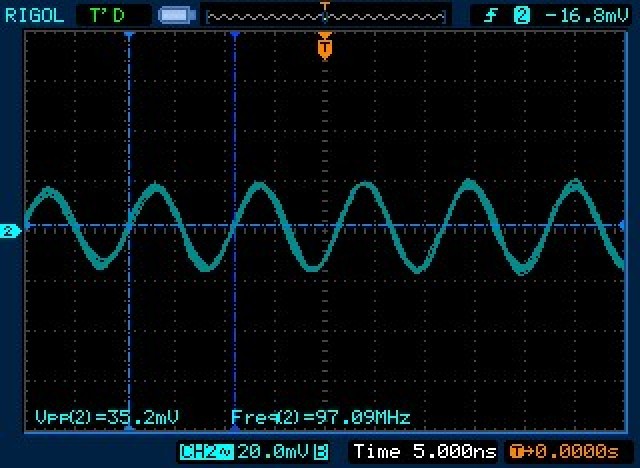Scope Noise
 RDL2004
Posts: 2,554
RDL2004
Posts: 2,554
Anybody have a clue what might be causing this?

That's with both the ground clip and the probe tip attached to the ground terminal of the square wave reference signal, so I guess that's some kind of common mode noise? The scope is set to the smallest divisions possible, but that still seems like a lot of noise. If I disconnect the probe from the scope it goes away, so I don't think it's any kind of internal problem. The signal kind of dances around a lot but the frequency is right around 95-96MHz. I had an old toroid core about 1/2" cross section, 2" diameter and with 5 or 6 turns of the probe cable wrapped around it the peak-peak dropped to about 12-15 mV. That's the best I've been able to do. Does this seem normal? I am far from an expert when it comes to scopes.
That's with both the ground clip and the probe tip attached to the ground terminal of the square wave reference signal, so I guess that's some kind of common mode noise? The scope is set to the smallest divisions possible, but that still seems like a lot of noise. If I disconnect the probe from the scope it goes away, so I don't think it's any kind of internal problem. The signal kind of dances around a lot but the frequency is right around 95-96MHz. I had an old toroid core about 1/2" cross section, 2" diameter and with 5 or 6 turns of the probe cable wrapped around it the peak-peak dropped to about 12-15 mV. That's the best I've been able to do. Does this seem normal? I am far from an expert when it comes to scopes.



Comments
Anyway, my guess is that the noise is from a noisy clock inside the oscilloscope. If the noise disappears with the ground lead clipped to the input, I wouldn't worry about the noise. (btw, about 1-2 mV of random noise is typical for the oscilloscopes I use)
Lawson
Not too bad, but as soon as I connect the probe to just about anything I get that noise in the 25-50 mV range. It's not bad if what you're looking at is at a fairly high voltage, but I'm trying to measure noise on a power supply circuit and this is just not working. You don't even want to know what it looks like plugged into a plastic breadboard, because that's really ugly.
I've tried several different probes, and I've turned off all the electronic stuff within about 10 feet of the scope but it doesn't seem to make any difference. I may have to haul out my old Tektronix analog scope to see what I get with it.
edit: yeah, this is a DS1052E. The 1102 goes down to microvolts? 20 millivolts is as low as this one goes.
I wonder if you might be able to detect it with an FM radio tuned to ~97 MHz?
FF
I have to point out that I only see this noise when the probe tip is connected to something. The big problem is that the power supply circuit I have built on a plastic breadboard, which isn't ground referenced, also picks up this noise and it's even worse there. Anyway, I was reading in the scope's manual and found out it has some digital filtering capability that I can turn on to hide this noise for now.
I have indeed tried several different probes, five to be exact, and both channels on the scope. All see pretty much the same signal. I also turned off all nearby electronic devices with the exception of the cable modem, wireless router and my little HP Microserver which are about 12 feet away. At some point I'll probably have to drag out the Tektronix scope to see what I can find with that. Thanks for all the ideas and suggestions
-Phil
I increased the time/div and noticed this:
Looks like some kind of AM at around 1.25 MHz (ignore the scope saying 50 MHz, it wasn't locking on)
If you are on good terms with a local PCB shop, get a sheet of Copper PCB laminate, and place that on your workbench, (fibre-glass side up
- we found that very good for quieting things down, when facing RF breakthrough...
Another approach is to make your own LPF-Probe, with well bonded coax, and a cap right at the end.
If you have feed thru caps, and only want to check PSU noise, then a 10:1 probe with 10K will likely be ok,
1k//1n feed thru is ~ 1MHz or a 1K:100ohm//1n is ~10MHz - and a ferrite bead will roll off more at 96MHz.
That's from when I first put it down, it's no longer as uncluttered
Yes the Aluminum foil under that blue mat should work just as well.
Is your PC case still open? A PC mother board can put out a considerably amount of RF and there is usually at least one clock running at 100MHz.
Lawson